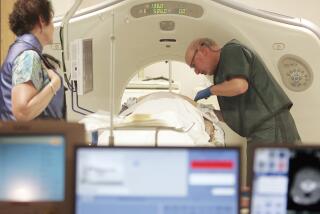Cutting Health Costs
- Share via
The American College of Physicians has made a valuable contribution to the control of health-care costs with its new guidelines for the use of medical tests. The national Blue Cross and Blue Shield Assn., which sponsored the research, underscored the importance of the guidelines by promptly adopting them. State affiliates are expected to follow suit.
There have been pressures on physicians to routinely order blood tests, electrocardiograms and chest X-rays. In many cases the doctors may have been trying to build a further defense against the risk of malpractice litigation. But the study found that in most cases the tests serve no useful purpose. This finding, and the authority of the College of Physicians, may strengthen the position of physicians facing court action.
The Blue Cross and Blue Shield Assn. president now estimates that more than $6 billion, and perhaps as much as $18 billion, is spent each year on procedures that do not aid in either diagnosis or treatment. Elimination of waste in the health-care system is of increasing importance because the system, while consuming close to 11% of the gross national product--more than in any other nation--still fails to provide assured care to about 37 million persons who have either no health insurance or inadequate coverage.
Guidelines for medical tests are but one of a number of initiatives now under way to control health-care costs. The Physician Payment Review Commission, in its first annual report last month, endorsed the establishment of a fee schedule for physicians under Medicare. That would profoundly affect the entire system, because Medicare alone provides an estimated 20% of physicians’ incomes. A Harvard study, which will be completed next year, is expected to inspire a reallocation and reassessment of fees among various types of physicians, with an increased share likely to go to the apparently undercompensated diagnosticians.
The Reagan Administration is moving this year to extend to some doctors the practice used by Medicare to compensate hospitals according to diagnostic related groups (DRGs)--that is, paying a flat fee per patient based on the patient’s diagnosis. This would be extended to cover those in three hospital-based medical specialties--anesthesiologists, radiologists and pathologists. Within Congress, where Medicare is certain to be cut by at least $1 billion in the 1988 budget, the reductions will all come from providers--primarily from fees paid to doctors for procedures thought to be overpriced, including cataract removal, hip reconstruction, coronary bypass and prostatectomy.
The cost-control efforts make sense, so long as they are sensitive to maintaining the quality of care, but they will provide only a partial answer to basic problems until access to adequate health-care protection is made available to all in the nation. Congress will begin work next month on access legislation seeking to assure everyone of basic protection. That will be expensive, whether it is borne by government or--as appears more likely--by employers. But the expense will be the more bearable as intelligent cost controls, such as the American College of Physicians’ test standards, are implemented.
More to Read
Sign up for Essential California
The most important California stories and recommendations in your inbox every morning.
You may occasionally receive promotional content from the Los Angeles Times.









